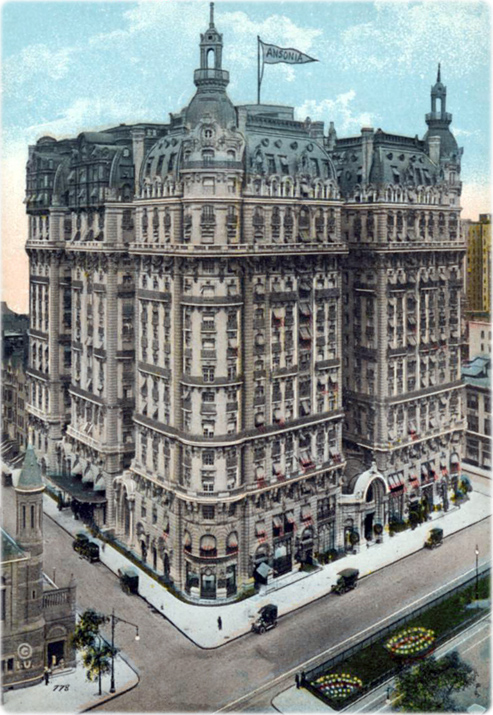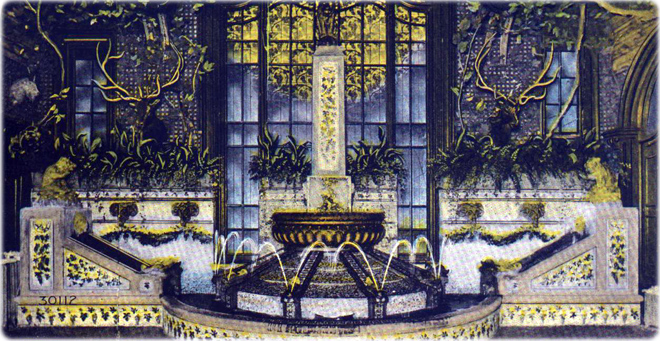
The Ansonia
The architectural landmark Ansonia Apartment Hotel opened its doors on February 7, 1903, at 2109 Broadway. The building is still there on the Upper West Side of Manhattan, occupying the entire western blockfront of Broadway (2101-2119), between West 73rd Street and West 74th St.
It was built by William Earle Dodge Stokes, the Phelps, Dodge copper heir and shareholder in the Ansonia Clock Company, and it was named after his grandfather, the industrialist Anson Greene Phelps (1781-1853). In 1897, Stokes commissioned French architect Paul Emile Duboy (1857-1907) to design the luxury hotel in Manhattan. Construction of the 17-story steel-frame structure began in 1899 and it opened its doors in 1903, with Beaux Arts façade and a mansard roof. It was then the largest residential hotel at the time and one of the tallest residential structures in the world.
On August 15, 1902, a strike and a deadlock at the Ansonia Hotel, over a claim of extra work, which had tied up work there for ten weeks, was broken and construction of the building resumed. It seems that the external structure of the building was completed, as the hotel's photo was published in the New-York Tribune two days later. On August 24, the New-York Tribune reported that a large number of apartments in the Ansonia were rented. On September 28, the newspaper reported that a force of 800 artisans were getting the building ready for occupancy. The hotel was managed by Slawson & Hobbs and Gurnsey E. Webb, formerly of the Plaza Hotel, assumed as resident manager for this firm in 1902, according to the newspaper.
On February 6, 1903, about 110 families were in the Ansonia, comprising some 500 people. Just before midnight a brisk blaze was found in the sub-cellar and a dense smoke curled up into the halls. People were taking down to the street while the firemen were at work. There was no panic and the damage was low.
On February 7, 1903, The Ansonia was formally opened, despite the fire the day before. On February 14, the building was practically completed. There were 120 families living in the Ansonia, according to the New-York Tribune.
The Hotel Ansonia was advertised, in the first years, as absolutely fireproof and the most superbly equipped hotel in the world. It had swimming pools, Turkish baths and restaurants decorated in the style of Louis XIV. Originally there was a kind of small farm on the roof, with chickens, pigs, ducks and goats to meet the demands of the hotel. It was closed by the Department of Health, in 1907.
In 1911, management in the Ansonia passed into the control of a new company headed by Mr. Frank W. Harriman and Mr. Gustav Obendorfer. In 1921, Edward M. Tierney was the managing director.
In 1926, there were 1260 rooms, also accepting transient guests.
In 1936, Ansonia announced a major improvement by installing air-conditioning throughout. It was New York's first air conditioned building. During World War II, the building's copper cornices were removed and melted down for the war effort. It was then a more modest hotel. In 1972, the building was designated a New York City Landmark and, in 1980, it was inducted to the National Register of Historic Places. In 1992, the Ansonia was converted to a condominium apartment building with 430 apartments.

|
Copyright © Geographic Guide - Historic Hotels in NYC. |
The Ansonia Apartment Hotel (2101–2119 Broadway) in a vintage postcard, postmark 1914.

Interior architecture of the Hotel Ansonia, 1919 (photo: Byron Co. / Museum of the City of New York).

The Grill Fountain inside the Ansonia, in a vintage postcard, 1909.

The Ansonia